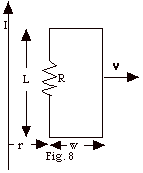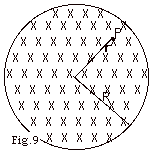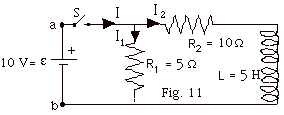|
|
|
1.
|
A square loop of wire, 2.0 m on a side,
has a resistance of 0.04 ω.
The loop is in a horizontal plane. Initially a magnetic field
B = 0.080 T points vertically downward. If this magnetic
field is reduced in magnitude at a constant rate to 0.040
T in 2.0 s, find the current and the sense of the current
as you look down on the loop. Note: 1 T = 1 N/A-m.

|
|
|
2.
|
A rectangular single-turn loop, with
dimensions a = 0.10 m and b = 0.15 m, lies in the X-Y plane,
as shown in Fig. 1. Within the loop there is a time-dependent
magnetic field B = 0.0120 N/A-m2(x sin103
s-1tj + y cos 103 s-1tk).
Determine the emf induced in the loop due to the changing
magnetic field.
|
|
|
3.
|
A toroid with a rectangular cross-section
(a = 0.02 m and b = 0.03 m) consists of N = 500 turns of wire
that carries a current I = Io sin ωt.
A loop that has N’ = 20 turns of wire
links the toroid (Fig. 2). Io = 50 A and
ω = 120 π
s-1. Determine the emf induced in the loop by the
changing current I.

|
|
|
4.
|
A long solenoid has n = 400 turns/m and
carries a current I = 30 A(1 - e-1.6t/s). Inside
the solenoid and coaxial with it is a loop that has a radius
R = 0.06 m and consists of N = 250 turns of wire (Fig. 3).
What is the emf induced in the loop?

|
|
|
5.
|
Figure 4 below shows a conducting rod
of length L being pulled along horizontal, frictionless, conducting
rails at a constant velocity v. A uniform vertical
magnetic field B out of the page fills the region in
which the rod moves. Find (a) the magnetic flux when the rod
is a distance x from the left end of the conducting rails,
(b) the change in magnetic flux when the rod moves
to the right a distance Δx,
(c) the induced emf ε, (d) the direction of the induced current, (e) the
induced current in the loop of total resistance R, (f) the
power dissipated in the resistance R in terms of B, L, v,
and R, (g) the force that must be applied by an external agent
to maintain the motion, (h) the power supplied by the external
agent, and (i) a comparison of the answers to (f) and (h).

|
|
|
6.
|
A bar of mass m = 0.50 kg slides downward
along stationary wires that are separated by a distance L
= 0.5 m and are joined at the top by a resistance R = 0.010
ω (Fig. 5 below). A uniform
magnetic field B = 0.20 N/A-m points into the paper. (a) If
the bar slides down, what is the sense of the current through
it? (b) At what speed v will the bar experience no force?

|
|
|
7.
|
A square loop of wire 1 m on a side moves
with a speed v = 0.5 m/s into a region of a magnetic field
B = 1.0 T out of the page, as shown in Fig. 6 below. At t
= 0, the loop of wire is just about to enter the magnetic
field. (a) Plot the magnetic flux through the loop of wire
as a function of time at 1-s intervals for 12 s. (b) Now plot
the induced emf in the coil for the same time and interval
of time. (c) If the coil has a resistance R = 0.01 ω, find the induced current in the coil at the
various times. Describe the sense of the current as the coil
passes through and out of the field.

|
|
|
8.
|
The axis of a circular loop of radius
R coincides with the z-axis (Fig. 7). At all points within
the area of the loop there is a non-uniform and time-varying
magnetic field B normal to the plane of the loop and
directed along the +z-axis. The magnitude of the field at
any point r distant from the axis is given by
B = Bo N/A-m - C N/A-m3-s2 r2t2,
where Bo and C are positive constants. Find (a)
the instantaneous magnetic flux dΦ
through the ring-like area of radius r and thickness dr, (b)
the instantaneous flux Φ
which links with the area of the loop of radius R, (c) the
emf induced in the loop and (d) the direction of positive
charge circulation when the loop is observed from above.

|
|
|
9.
|
A rod with length L, mass m and resistance
R slides without friction down two parallel conducting rails
inclined at an angle Θ
with the horizontal. The rails and the bar that connects them
at the bottom of the incline have negligible resistance. Find
the constant velocity v achieved by the wire in a uniform
magnetic field B directed vertically upward.
|
|
|
10.
|
A rectangular loop of length L and width
w moves with velocity v away from a long wire that
carries a current I in the plane of the loop (Fig. 8). The
total resistance of the loop is R. Derive an expression that
gives the current in the loop at the instant the near side
is a distance r from the wire. Is the induced current clockwise
or counterclockwise in the loop?

|
|
|
11.
|
A long solenoid has n turns per unit
length and a radius R. (a) What is its inductance per unit
length? (b) If the solenoid has 2000 turns per meter and a
radius of 0.02 m, find the inductance for a 1.0 m segment
of this solenoid. (c) If the current in the solenoid is changing
at the rate of 3.0 x 102 A/s, find the induced
emf in this segment.
|
|
|
12.
|
A magnetic field directed into the page
changes with time according to B = (0.05s-2t2
+ 0.4)T. The field has a circular cross-section of
radius R = 0.05 m (Fig. 9). What are the direction and the
magnitude of the electric field E at point P when t
= 4 s and r = 0.04 m?

|
|
|
13.
|
To measure the inductance and the internal
resistance of an inductor, a physicist first connects the
inductor across a 3.0 V battery. She measures a final, steady
current of 24 A. Then she short-circuits the inductor with
a resistanceless wire and finds that the current decreases
from 24 A to 12 A in 0.22s. Find (a) the internal resistance
and (b) the inductance of the inductor.
|
|
|
14.
|
An LC circuit has an inductance of 5.0
x 10-2 H and a capacitance of 5.0 x 10-6 F.
At t = 0, the capacitor is fully charged with qm
= 1.0 x 10-4 C. (a) What is the energy
in this circuit? (b) At what time, after t = 0, will the energy
be purely magnetic? (c) At what later time will it be purely
electric again?
|
|
|
15.
|
A toroid of square cross section has
inner radius R and sides a as shown in Fig. 10. The toroid
has N turns and carries a current I. Find (a) the inductance
of the toroid, (b) the magnetic energy density of the toroid,
(c) the total magnetic energy stored in the toroid. (d) Use
the expression for the magnetic energy U = 1/2 LI2
and compare with your answer to (c).

|
|
|
16.
|
Complete the relations below in terms
of the field quantities E and/or B and give
the meaning of the term appearing on the right side:
(a) d /dt ∫ B . dA =
where the left-hand side represents the time rate of change
of the magnetic flux.
(b) µoεo
d /dt ∫ E . dA
where the left-hand side represents the time rate of change
of the electric flux.
|
|
|
17.
|
Consider the case of linearly polarized
plane electromagnetic waves in free space where the phase
velocity of the waves is c = 3 x 108 m/s.
Prove the following:
(a) The Poynting vector may be expressed as εoc2E
x B.
(b) The electric and magnetic field energy densities are equal.
(c) Sav = (1.33 x 10-3 C2/N-m-s)E2m,
where Em is the maximum value of E.
|
|
|
18.
|
Consider a long cylindrical conductor
of radius r and length L. A steady current I is distributed
uniformly across the cross section of the conductor whose
resistance is R. Calculate (a) the magnitudes of the electric
and magnetic fields at the surface of the conductor, (b) the
magnitude of the Poynting vector, and (c) show that energy
flows into the conductor across its surface at a rate which
is equal to the rate of heat production within the conductor.
|
|
|
19.
|
A laser produces an average power or
7.0 W in a light beam 1.00 mm in diameter. Find (a) the average
intensity and (b) the maximum value of the electric field.
|
|
|
20.
|
A parallel plate capacitor consists of
two circular plates of radius R and separation d. The charge
q on the plates varies with time such that q =
q0 sin ωt.
Find an expression (a) for the electric field E between the
plates in terms of q, (b) for the electric flux ΦE
for a distance r ≤ R from the axis of the plates, (c)
for the magnetic field B at this distance r and (d) for the
Poynting vector S. (e) Show that when the capacitor
is being charged, S is directed toward the axis of
the plates and that there is a flow of energy into the region
between the plates. (f) Calculate the rate of energy flow
into the capacitor through the gap between the plates and
compare the result with the rate of increase of field energy
in the volume between the plates.
|
|
|
21.
|
An LRC series circuit has L = 10
mH, C = 1.0 µF, R = 3.3 ω
across a potential difference of 1.0 V. Find (a)
the resonance frequency ωo,
(b) the maximum current Ip in the circuit at resonance,
(c) the average power dissipated per period at resonance,
(d) the maximum current Ip in the circuit and the
average power dissipated per period when the frequency is
5 percent lower than the resonance frequency.
|
|
|
22.
|
In the circuit of Fig. 11, ε
= 10 V, R1 = 5.0 ω,
R2 = 10.0 ω,
and L = 5.0 H. For the switch S just closed, find the values
of (a) the current I1 through R1, (b) the
current I2 through R2, (c) the current
I through the switch, (d) the potential difference across
R2, (e) the potential difference across L, and
(f) dI2/dt. Repeat all of the above for a time
when the switch has been closed for a very long time.

|
|
|
23.
|
(a) For the circuit of Fig. 12a, write
an expression for the ratio of Vp out to Vp in.
Sketch a graph of Vp out / Vp
in as a function of ω.
(b) Repeat (a) for Fig. 12b. For which of the two circuits
is there a preferential for the high frequencies (called a
high-pass filter)? The other one is called a low-pass filter
because there is a preferential for the low frequencies.

|
|
|
24.
|
(a) For the circuit of Fig. 13a, write
an expression for the ratio of Vp out to Vp in.
Sketch a graph of Vp out / Vp in
as a function of ω. (b)
Repeat (a) for Fig. 13b. For which of the two circuits is
there a preferential for the high frequencies (called a high-pass
filter)? The other one is called a low-pass filter because
there is a preferential for the low frequencies.

|
|
|
25.
|
The average power Pav = Irms2
R. (a) Show that this can also be written as Vrms2
Rω2/[R2ω2
+ L2(ω2
- ωo2)2,
where ωo =
(1/LC)1/2. (b) Find the maximum value of the average
power when ω = ωo.
(c) Sketch a graph of Pav as a function of ω.
(d) Find the values of the ω's
for which the average power is one-half the maximum value.
(e) The sharpness (narrowness of the maximum) of a graph of
Pav as a function of ω
is usually called the quality factor. The quality factor is
denoted by Qo (note it has nothing to do with
charge) and is given by Qo = ωo/Δω,
where Δω is the difference
between the two values of ω
you found in (d). Using your result found in (d) show that
you may write Qo = ωoL/R.
|
|
|
26.
|
Can the amplitude of the voltage across
an inductor be greater than the amplitude of the generator
voltage in an RLC circuit? Consider an RLC circuit with Vp
= 10 V, R = 10 ω,
L = 1.0 H, and C = 1.0 µF. Find the amplitude
across the inductor at resonance.
|
|